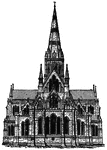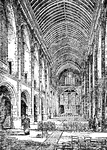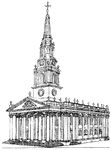The United Kingdom Churches and Cathedrals ClipArt gallery offers 139 images of UK places of worship.
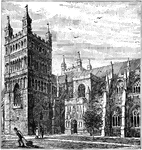
Exeter Cathedral
The founding of the cathedral at Exeter, dedicated to Saint Peter, dates from 1050, when the seat of…
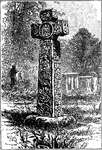
Eyam Churchyard Cross
Eyam churchyard contains a Saxon cross dated to the 7th or 8th centuries. Initially, it was located…
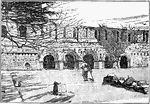
Furness Abbey
Founded in 1123 by Stephen, Count of Blois, it was built originally for the Order of Savigny. Located…

Gloucester Cathedral
"Lady Chapel of Gloucester Cathedral, England, looking toward the nave." -Whitney, 1911
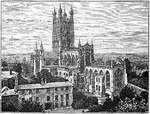
Gloucester Cathedral (Abbey) Church
The cathedral consists of a Norman nucleus (Walter de Lacy is buried there), with additions in every…
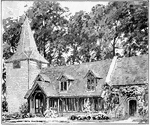
Greenstead Church
Greensted Church, in the small village of Greensted, near Chipping Ongar in Essex, England, is the oldest…
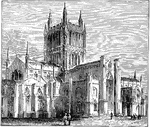
Hereford Cathedral
In the war between King and Parliament (the English Civil War) the city of Hereford fell into the hands…
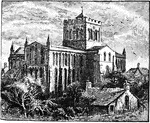
Hexham Abbey
There has been a church on the site for over 1300 years since Etheldreda, Queen of Northumbria made…
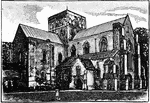
Holy Cross Church, Near Winchester
The Hospital of St. Cross is a medieval almshouse in Winchester, England, founded between 1133 and 1136…

Jarrow Church Tower
The present parish church of St. Peter's at Wearmouth, on the north bank of the River Wear, occupies…

King's College Chapel, Cambridge
Henry VI planned a university counterpart to Eton College, the chapel being the only portion that was…
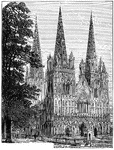
Lichfield Cathedral
Lichfield Cathedral is situated in Lichfield, Staffordshire, England. It is the only medieval English…
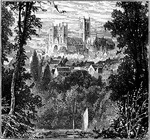
Lincoln Cathedral
It was the tallest building in the world for over 200 years (1300-1549), but the central spire collapsed…

Lincoln Cathedral
"Sectional compartment of the Nave of Lincoln Cathedral." — Encyclopedia Britanica, 1893

Lincoln Cathedral
"Sectional compartment of the Choir of Lincoln Cathedral." — Encyclopedia Britanica, 1893
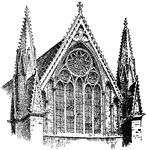
Lincoln Cathedral
The Lincoln Cathedral (The Cathedral Church of the Blessed Virgin Mary of Lincoln) is a geometric style…
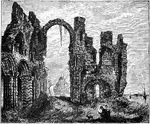
Lindisfarne Priory Ruins before 1860
The monastery of Lindisfarne was founded by Irish born Saint Aidan, who had been sent from Iona off…
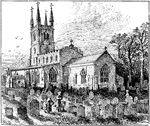
Lutterworth Church
In the 14th century religious reformer Canon John Wyclif was Rector in Lutterworth's Parish Church of…
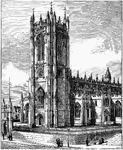
Manchester Cathedral
Manchester Cathedral is a Medieval church located on Victoria Street in central Manchester and is the…

Minster Church, Isle of Sheppey
In English usage, Minster is an honorific title attached to certain major medieval churches. Most of…
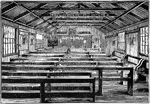
A Temporary Mission Room
A Christian mission has been widely defined, since the Lausanne Congress of 1974, as that which is designed…
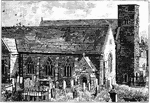
Monkwearmouth Church
The present parish church of St. Peter's at Wearmouth, on the north bank of the River Wear, occupies…
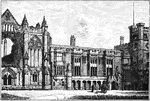
Newstead Abbey
Newstead Abbey, in Nottinghamshire, England, originally an Augustinian priory, is now best known as…

Old St. Paul's Cathedral
Old St. Paul's is a name used to refer to the Gothic cathedral in the City of London built between 1087…
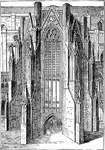
Chapter House of Old St. Paul's
Old St. Paul's is a name used to refer to the Gothic cathedral in the City of London built between 1087…
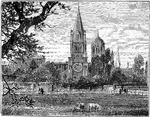
Oxford Cathedral
In 1522, the priory was surrendered to Cardinal Wolsey, having selected it as a site for his proposed…
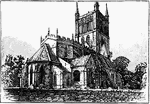
Pershore Abbey
Between AD 681 and 689, King æthelred of Mercia gave estates at Pershore to the Bishop of Worcester…
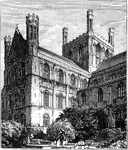
Peterborough Cathedral
Founded in the Saxon period, the architecture is mainly Norman following a rebuilding in the 12th century.…

Piscina in Morning Chapel, Lincoln Cathedral
A piscina is a shallow basin usually located in an architectural niche of a church. It is used by the…
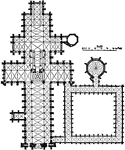
Plan of Salisbury Cathedral, 1075–1092
This is a plan of the Salisbury Cathedral, England. It is an example of English Gothic architecture.…

Plan of St Paul's Cathedral, London, 1675–1710
This is a plan of the St Paul's Cathedral in London, England. It is an example of English Renaissance…
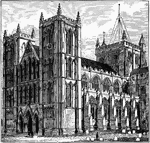
Ripon Cathedral
People have been coming to worship and pray at Ripon for more than 1,350 years. The Cathedral building…
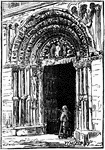
Rochester Cathedral, West Door
The present building is widely regarded as one of the finest Norman cathedrals in the country, with…
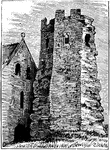
Roman Lighthouse, and Part of St. Mary's Church, Dover
The lighthouse on the Eastern Heights still stands in the grounds of Dover Castle to 80 foot (24 m)…
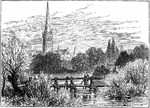
Salisbury Cathedral
Salisbury Cathedral is an Anglican cathedral in Salisbury, England, considered one of the leading examples…

Church Saxon Architecture
Tower of Sompting church, Essex. Saxon Architecture is the earliest stage of native English architecture,…
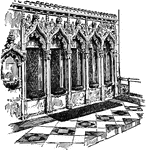
Sedilia
The sedilia in Southwell Minster, England. In church architecture, a sedile is a seat near the altar…
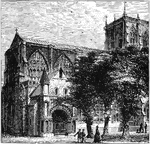
Sherborne Minster
The Abbey Church of St. Mary the Virgin at Sherborne in the English county of Dorset, is usually called…

Sompting Church Tower
The church was originally built by the Saxons around 960, then was adapted by the Normans when William…

Southwell Minster
The earliest church on the site is believed to have been founded in 627 by Paulinus, the first Archbishop…
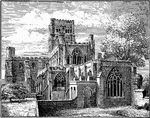
St. Alban's Abbey before the Modern Restoration
St. Alban's Abbey, Mainz (Stift St. Alban vor Mainz) originated as a Benedictine abbey, founded in 787…

St. Alban's Monastery Gate
This is the only building to survive. It was built c.1365 after its predecessor had been destroyed in…
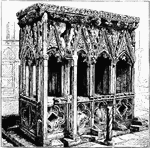
St. Alban's Shrine
Saint Alban was the first British Christian martyr. Along with his fellow saints Julius and Aaron, Alban…

St. Aldhelm's Church, Bradford-on-Avon
Notable is the Saxon church (dedicated to St. Laurence), which may have been founded by St. Aldhelm…
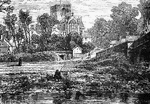
St. Asaph Cathedral
St Asaph Cathedral, (Welsh: Eglwys Gadeiriol Llanelwy) at St Asaph, Denbighshire, north Wales, is sometimes…
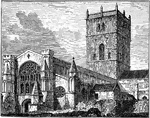
St. David's Cathedral
The monastic community was founded by Saint David, Abbot of Menevia, who died in AD589. Between AD645…
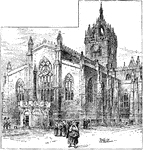
St. Giles' Cathedral, Edinburgh
A prominent feature of the Edinburgh skyline, St. Giles' Cathedral or the High Kirk of Edinburgh is…
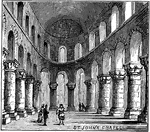
St. John's Chapel in the Tower
St. John's Chapel, or the Chapel of St. John the Evangelist, is located in the Tower of London. Dating…
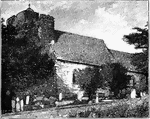
St. Martin's Church, Canterbury
St. Martin's was the private chapel of Queen Bertha of Kent in the 6th Century before Augustine arrived…

St. Martin's Church, Canterbury
"This church occupies the site of a chapel built in the Roman period and standing at the time of the…
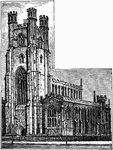
St. Mary's Church, Cambridge
In addition to being a parish church in the Diocese of Ely, it is the University Church for the University…
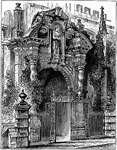
Porch of St. Mary's, Oxford
A church was established on this site, at the centre of the old walled city, in Anglo Saxon times. St…
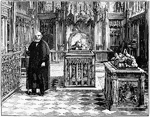
Beauchamp Chantry, St. Mary's, Warwick
The church foundations date back nearly nine hundred years, being created by Roger de Beaumont, 2nd…
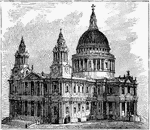
St. Paul's Cathedral
St Paul's Cathedral, is the Anglican cathedral on Ludgate Hill, in the City of London, and the seat…

St. Paul's Cathedral, London (Interior)
St Paul's Cathedral, is the Anglican cathedral on Ludgate Hill, in the City of London, and the seat…
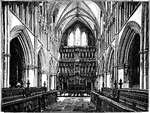
Choir of St. Saviour's, Southwark
It is the mother church of the Anglican Diocese of Southwark. It has been a place of Christian worship…
